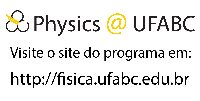Banca de QUALIFICAÇÃO: BRUNO PINHEIRO TONIATO
Uma banca de QUALIFICAÇÃO de MESTRADO foi cadastrada pelo programa.STUDENT : BRUNO PINHEIRO TONIATO
DATE: 19/03/2025
TIME: 15:00
LOCAL: https://conferenciaweb.rnp.br/ufabc/defesa-qualificação-bruno-toniato
TITLE:
Holographic QCD and quarkonium melting: Finite temperature, density, and external field effects in self-consistent dynamical models.
PAGES: 80
BIG AREA: Ciências Exatas e da Terra
AREA: Física
SUBÁREA: Física das Partículas Elementares e Campos
SPECIALTY: Teoria Geral de Partículas e Campos
SUMMARY:
The AdS/CFT correspondence has led to a surge of models describing strongly coupled gauge theories, providing a powerful framework for studying non-perturbative phenomena in QCD and condensed matter systems. In this work, we developed a self-consistent dynamical holographic QCD model within the Einstein-Maxwell-Dilaton (EMD) framework to study the mass spectra and melting behavior of heavy and exotic mesons at finite temperature and finite density. Unlike previous approaches that introduced a non-quadratic dilaton profile by hand, we constructed the model by solving the coupled Einstein, Maxwell, and dilaton field equations, ensuring mathematical self-consistency. At finite temperature, we investigated the confinement-deconfinement transition via a Hawking-Page phase transition and computed spectral functions to track the sequential melting of quarkonia as the temperature increased. Extending the study to finite density, we examined the impact of the baryon chemical potential on meson stability, revealing significant modifications in spectral peaks and effective potentials. Our results indicated a more rapid melting of mesonic states in the deconfined phase as the chemical potential increased. Furthermore, we explored the dual of the small/large black hole transition, identifying a first-order phase transition line terminating at a second-order critical point. Interestingly, we observed that the spectral functions evolve smoothly across this transition. Additionally, we investigated the melting behavior of quarkonia in an external magnetic field using a dynamical Einstein-Born-Infeld-Dilaton model. The non-linear nature of the model allowed us to couple the magnetic field to the quarkonium inner structure without introducing back-reacting charged flavor degrees of freedom. By computing spectral functions, we determined the magnetic field-dependent melting temperature, revealing a transition from inverse magnetic to magnetic catalysis as the field strength increased.
COMMITTEE MEMBERS:
Presidente - Interno ao Programa - 382324 - VILSON TONIN ZANCHIN
Membro Titular - Examinador(a) Interno ao Programa - 1545176 - MARCELO AUGUSTO LEIGUI DE OLIVEIRA
Membro Titular - Examinador(a) Externo à Instituição - GASTAO INACIO KREIN - UNESP
Membro Suplente - Examinador(a) Interno ao Programa - 1907614 - MAURICIO RICHARTZ
Membro Suplente - Examinador(a) Externo ao Programa - 1765195 - RICARDO ROCAMORA PASZKO
Membro Suplente - Examinador(a) Externo à Instituição - GAYANE KARAPETYAN - UFABC




